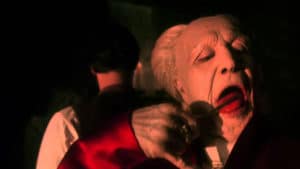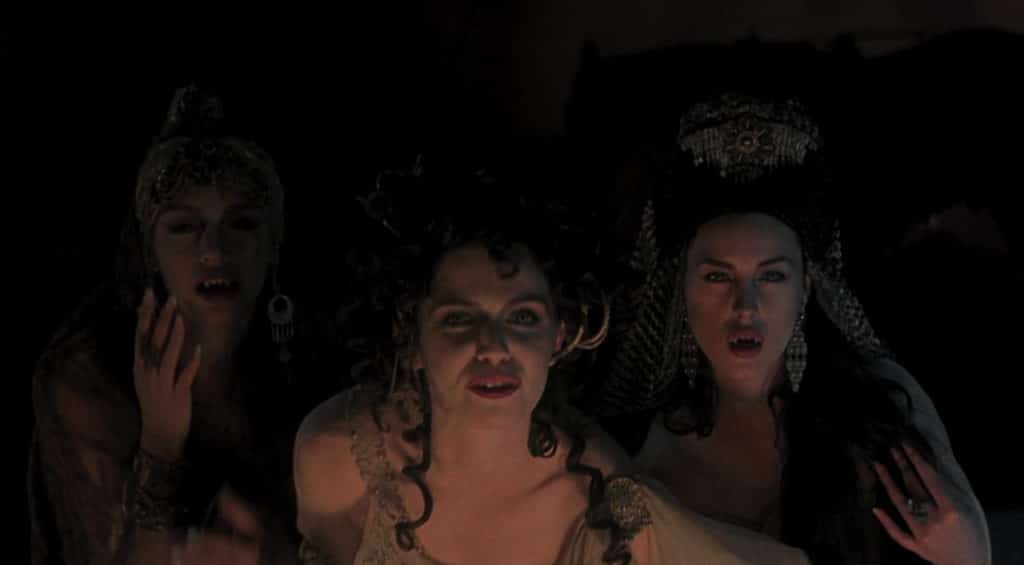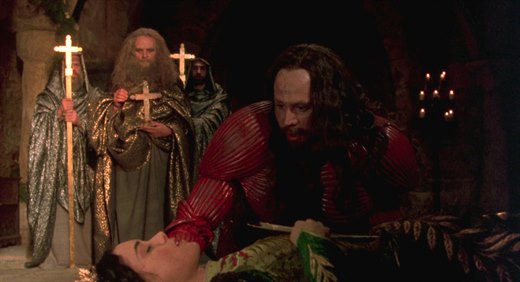
The vampire – at least as we used to know it – seems to have fallen out of favour in recent years. By no means has it disappeared, but certainly, as on-screen monsters go, it’s no longer in its ascendant. Terrific, spellbinding horrors continue to be made, sure, even if more often than not as remakes or prequels/sequels – but glorious, gratuitous cinematic vampires seem harder and harder to find. Vampires have either paced into the modern day, in drab clothes to match, or else they’ve come to identify as something altogether different from a blood-drinker – a creature that can be mollified, without the old need to take a human life. There have, of course, been some superb vampire horror stories in recent years. However, in many other ways, it feels like a very, very long time indeed since Francis Ford Coppola unfolded the last great Dracula movie.
The character of Dracula doesn’t just have a long history with horror; the history of horror is Dracula, and there have been regular interpretations of Bram Stoker’s novel since the inception of cinema in the early 20th Century. In fact, Nosferatu (1922) eventually appeared out of a legal wrangle between director Murnau and Stoker’s still-living widow; subsequent name changes to characters stemmed from issues around copyright. Funnily enough, this tussle between the Stoker estate and the filmmaker reaffirmed the novel’s fading popularity, and probably contributed to the horde of Draculas which eventually graced the screen. The classic ‘Universal Monsters’ legendarily numbered Dracula amongst their ranks, and versions of the charming, deadly aristocratic Dracula embodied by Bela Lugosi dominated horror cinema for the next forty years at least. Advances in technology and filming techniques allowed filmmakers to make Dracula more visceral, more preternaturally frightening perhaps, but he more often than not retained that suave, aristocratic veneer; the cinematic Dracula is now a cultural archetype, a mass-produced and understood image which adorns anything from cereal boxes to kids’ masks.
In terms of horror films, the more successes Dracula enjoyed, the more scope for interpretation there was, but it was some time before a filmmaker earnestly took up the imperative so resonantly uttered by one of the world’s favourite cinematic Draculas, Christopher Lee, whenever he was asked about how you could improve one of his most famous roles: “use the words which Stoker has written”. (When Lee felt that scripts deviated too far into silliness, he elected to play the role mute, remember, so we can assume he meant what he said). However, not only did Francis Ford Coppola ‘use the words’, he also – via screenplay writer James V. Hart – completely transformed Stoker’s original novel, melding the legend of Transylvanian nobleman Vlad Tepes with the fantastical events of the text in a way which Stoker never did.
Books have been written and wars have been fought (or very nearly) about just how much inspiration Stoker took from reading about Tepes, a 15th Century prince whose barbarism is as feted as his fierce nationalism. It’s not for me to get too mired in all of that here, but certainly, Hart’s screenplay begins by placing the narrative squarely in Tepes’s court. In so doing, all the ambiguities regarding Stoker’s book, you know, the ones which have spawned a thousand essays on just why in the hell a Transylvanian nobleman suddenly decides to up sticks (and cases of earth) and move to England, are neatly skewered. Pardon me the pun.
In Coppola’s film, Dracula is Vlad Dracula; no further questions. His great victories over the empire-building Ottomans have secured his nation and his Church, but the church can offer him no gratitude, no spiritual flexibility. The recent suicide of his princess, upon hearing from the Turks that Vlad had in fact been killed, means that she is damned – whoever her beloved is and whatever he has achieved is immaterial. His ensuing grief and rage generates a blasphemy so aberrant that the very crucifixes pour with blood. He becomes a monster, and is damned to live forever for his crimes against God.
In one incredible cinematic sequence, there we have it. We know why Dracula continues to live. That tantalising line in the novel where Dracula asserts that yes, he has in fact loved, suddenly makes profound sense in terms of the narrative. It’s even – whisper it – an improvement on the source text, in my humble opinion.
 I may as well be blunt here: it’s a notable book for many reasons, not least of which in how it’s generated so many more creative works down through the years, but I don’t think Dracula is a great novel in itself. The epistolary frame is interesting in terms of structure, and it’s cleverly pieced together, but this keeps readers at a distance from its protagonists; certain characters descend readily into farce (and are played faithfully as such in the film!) and there are a number of thankless questions, making the novel feel a bit like a whistle-stop tour of a fascinating place where you never have long to pause and look about you. Francis Ford Coppola’s Dracula adds some sense and coherence to all of this by motivating its monster with undying love, but it doesn’t then abandon the effective and horrifying scenes from the book, either. Some of these – the creature turning into multiple rats which all flee, the still aged Dracula licking Harker’s blood from a cutthroat razor or impossibly scuttling down the castle’s steep walls – have lost none of their power. It’s these contrasts that allows the audience to see a fully-fleshed antagonist; to feel some ‘sympathy for the devil’, or at least sympathy for a damned being. Against the luxuriant add-on of what’s effectively a reincarnation based love story, it’s an absorbing array of contrasts.
I may as well be blunt here: it’s a notable book for many reasons, not least of which in how it’s generated so many more creative works down through the years, but I don’t think Dracula is a great novel in itself. The epistolary frame is interesting in terms of structure, and it’s cleverly pieced together, but this keeps readers at a distance from its protagonists; certain characters descend readily into farce (and are played faithfully as such in the film!) and there are a number of thankless questions, making the novel feel a bit like a whistle-stop tour of a fascinating place where you never have long to pause and look about you. Francis Ford Coppola’s Dracula adds some sense and coherence to all of this by motivating its monster with undying love, but it doesn’t then abandon the effective and horrifying scenes from the book, either. Some of these – the creature turning into multiple rats which all flee, the still aged Dracula licking Harker’s blood from a cutthroat razor or impossibly scuttling down the castle’s steep walls – have lost none of their power. It’s these contrasts that allows the audience to see a fully-fleshed antagonist; to feel some ‘sympathy for the devil’, or at least sympathy for a damned being. Against the luxuriant add-on of what’s effectively a reincarnation based love story, it’s an absorbing array of contrasts.
This aspect is, by far, not the film’s only strength. It boasts a fantastic aesthetic sensibility throughout, combining shadow theatre with sweeping vistas and an immaculately staged version of the historical with cedes into the impossible. In many respects, Coppola’s vision represents the idea of the ‘hyperreal’, weaving something seemingly impossibly lurid out of even the ostensibly most realistic scenes. This kind of flourish is everywhere, as are a number of forced perspectives which trick the eye and add to the deeply dreamlike atmosphere. Dracula’s armour is blood red, foreshadowing what is to come; Oldman’s turn as the literally ancient Count Dracula, apart from rendering him unrecognisable, takes plausible shape as an elderly European nobleman, dressed hair and all; Sadie Frost transforms from a pre-Raphaelite into a Vaudeville harlot and finally into a beautiful corpse, her funereal/bridal clothes a perfect picture of excessive modesty – Frost’s ‘Bloofer Lady’ is perfect, and whilst more beautiful than terrifying (we owe Frank Langella’s Dracula that honour) it captures the threat which this character poses in the novel: she can still be sexual.
 No one can ever accuse Coppola of shying away from things which could only ever be alluded to in 19th Century fiction. The Carmillas and Draculas of the day afforded the tantalising scope to be salacious, but likewise the sexual mores of the day meant calling things to a halt not too long after introducing this possibility of sex, couching even these supernatural encounters in veiled words and glaring omissions. Compare that, to give just one example, to the ‘Dracula’s Brides’ sequence in the 1992 release. Okay, even if the blood-sharing scene between Mina and the Count holds back to an extent (though still sending a million hearts a-flutter, no doubt) then the unholy trinity who make Harker their foodstuff/plaything must have been quite an education for more than a few young men – or women, for that matter. After that, we should be a hell of a lot more understanding as to why Harker’s speech sounds a little off. Then there’s what happens to Lucy Westenra, which is recounted as a ‘mystery illness’ in the novel, but is rendered overtly sexual on screen, in a series of eroticised, if dubiously consensual encounters – in one of which Oldman was advised to whisper scandalous nothings off-screen to actress Sadie Frost in order to encourage her to writhe appealingly. Coppola always intended his film to have this kind of sensory overload, storyboarding about a thousand scenes altogether and insisting that the costumes, alongside the mise-en-scène, underpinned the whole.
No one can ever accuse Coppola of shying away from things which could only ever be alluded to in 19th Century fiction. The Carmillas and Draculas of the day afforded the tantalising scope to be salacious, but likewise the sexual mores of the day meant calling things to a halt not too long after introducing this possibility of sex, couching even these supernatural encounters in veiled words and glaring omissions. Compare that, to give just one example, to the ‘Dracula’s Brides’ sequence in the 1992 release. Okay, even if the blood-sharing scene between Mina and the Count holds back to an extent (though still sending a million hearts a-flutter, no doubt) then the unholy trinity who make Harker their foodstuff/plaything must have been quite an education for more than a few young men – or women, for that matter. After that, we should be a hell of a lot more understanding as to why Harker’s speech sounds a little off. Then there’s what happens to Lucy Westenra, which is recounted as a ‘mystery illness’ in the novel, but is rendered overtly sexual on screen, in a series of eroticised, if dubiously consensual encounters – in one of which Oldman was advised to whisper scandalous nothings off-screen to actress Sadie Frost in order to encourage her to writhe appealingly. Coppola always intended his film to have this kind of sensory overload, storyboarding about a thousand scenes altogether and insisting that the costumes, alongside the mise-en-scène, underpinned the whole.
Over the ensuing years, much has been made of the film’s flaws – of which I accept there are many, even if for me they are still minor points, a mispronunciation of ‘bastard’ here, a somewhat dialled-in Dutchman there. Overall, this is still simply one of the most sumptuous adaptations of a notorious and oddly-beloved novel there has ever been, and I do not think that we have really seen its like since. It’ll always have a place in my heart, and it’ll always feel like a formative film, one of those many which, over the years, settle on you as a fond memory.
In the intervening years, perhaps only Dracula Untold has sought to interweave history with vampire fantasy on a similar ‘lost love’ theme, but, as broadly entertaining as it is, it just doesn’t come together in the same way. So, assuming we can ignore Dario Argento’s more recent jaw-dropping foray into the source material, will Dracula ever be back? Or has he now crossed the divide into pop culture, there to remain? Or, is this just the perception of viewers like me, all too happy to discard erstwhile Draculas as counterfeit, crass or otherwise lacking?
Perhaps, perhaps. But if Coppola was the man to bring us Count Dracula’s true on-screen swansong in 1992, then I think that it’s an extraordinary place to part company.
